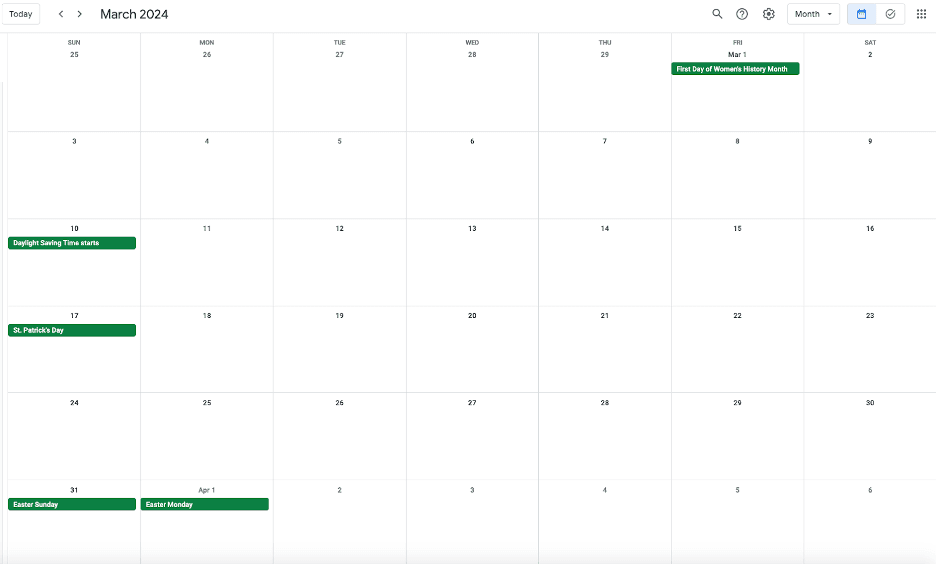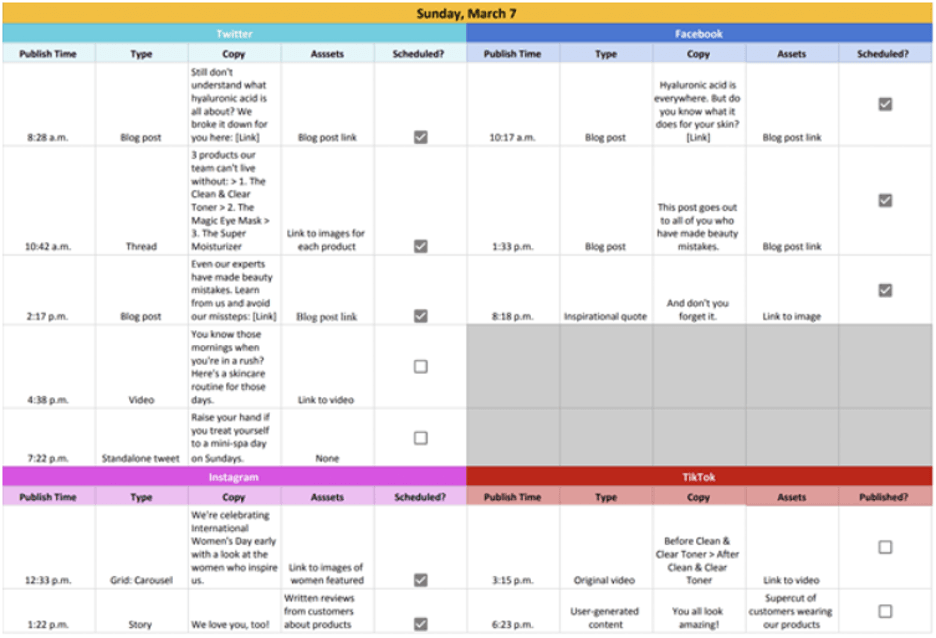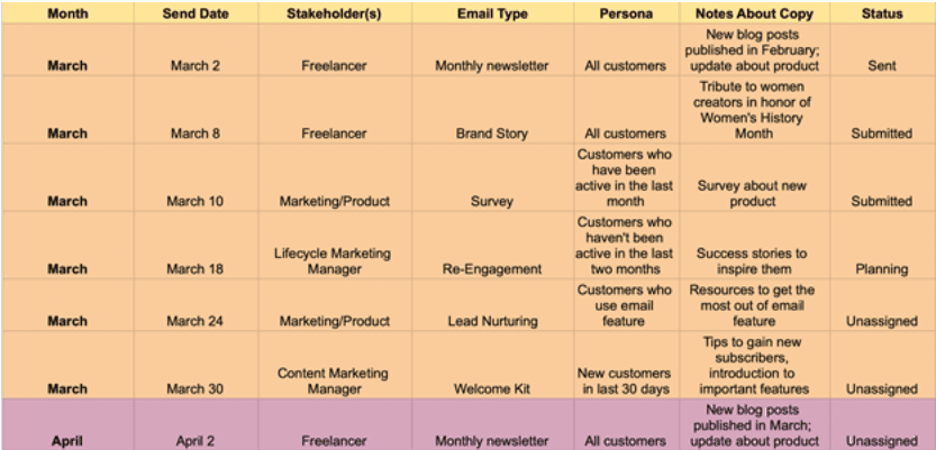Business News Daily provides resources, advice and product reviews to drive business growth. Our mission is to equip business owners with the knowledge and confidence to make informed decisions. As part of that, we recommend products and services for their success.
We collaborate with business-to-business vendors, connecting them with potential buyers. In some cases, we earn commissions when sales are made through our referrals. These financial relationships support our content but do not dictate our recommendations. Our editorial team independently evaluates products based on thousands of hours of research. We are committed to providing trustworthy advice for businesses. Learn more about our full process and see who our partners are here.
How to Create a Content Calendar
Meet your editorial goals and objectives with organized, consistent content.

Table of Contents
Creating and publishing content regularly requires organization. That’s where a content calendar comes into play.
While some are more detailed than others, a content calendar helps you plan content weeks or months in advance. Creating a content calendar from scratch might seem intimidating or overwhelming, but it’s doable. We’ll explain why a content calendar is essential to your content marketing efforts and customer communications and how to create one.
What is a content calendar?
A content calendar, sometimes called an editorial calendar, is a schedule of the content you plan to write, produce and publish. You can create one using a spreadsheet, an actual calendar, or various business organization apps and tools.
A content calendar ensures you know when various customer communication content will go live. It outlines precisely what you’ll include in blog posts, newsletters, website content, social media posts, marketing emails and more.
Editor’s note: Looking for the right project management software for your business? Fill out the below questionnaire to have our vendor partners contact you about your needs.
What is a content calendar?
A content calendar, sometimes called an editorial calendar, is a schedule of the content you plan to write, produce and publish. You can create one using a spreadsheet, an actual calendar, or various business organization apps and tools.
A content calendar ensures you know when various customer communication content will go live. It outlines precisely what you’ll include in blog posts, newsletters, website content, social media posts, marketing emails and more.
A content calendar typically includes the following in its entries:
- What the content will entail
- When and where content will be published
- The content author’s name
- When the content was assigned
- When the content is due
- Notes about the content
- Supporting promotional activities (e.g., podcast interviews)
- The final product
How do you create a content calendar?
Creating a content calendar can seem overwhelming. However, it involves straightforward steps that will help you clarify your vision and execute your content strategy.
1. Analyze your existing content.
Start with auditing your content. Use CRM analytics and other marketing analytics tools to pinpoint content that has successfully connected with your target customers. For example, if you note that customer stories and case studies perform well, you’ll know that continuing to create this type of content is worthwhile.
You must also focus on your goals. For example, if you want to generate sales leads, hone in on content that resonates with prospective customers. If you want to boost web traffic, focus on content that encourages readers to click on a link and head to your website.
2. Decide what types of content you’ll pursue.
You may create a content calendar for blog entries, social media posts or marketing emails – or all of the above. In any case, you must know precisely what type of content you’ll create for each channel. Here are a few examples:
- Blogs: When planning blog entries, you must decide on topics that make sense for your audience and general subject matter. For example, if you’re planning entries for your gardening blog, you might brainstorm posts on gardening basics, planting perennials, landscape gardening and more. You’ll decide which posts you’ll publish on which dates and how frequently you want to post.
- Social media: When planning your social media content, you must decide on platforms and platform-specific content. Staying with the gardening example, you may decide that Instagram should be a primary focus. Because this is a visual platform, you’ll select appropriate photos, write captions, and include relevant keywords and hashtags. You’ll determine the best posting frequency and schedule your posts.
- Email marketing: Planning your email marketing messages is similar. You’ll establish how often you’ll send emails, what information you’ll include and what calls to action (CTAs) will generate your desired response.
3. Research keywords and brainstorm content.
Before filling out your content calendar, brainstorm and conduct keyword research to inspire content ideas that align with your messaging and brand.
For example, say you operate an e-commerce store that sells 3D-printed miniatures. In this case, you may decide to target keywords like “dungeons and dragons minis” in your company blog posts and post photos of your 3D-printed products on social media platforms that link to your blog or website. Your email marketing content could include blog post teasers.
Repurposing your content across various content platforms and marketing channels saves time and ensures your content is consistent and aligned with your overall brand.
4. Find the best platform for your content calendar.
When choosing a platform, consider your budget, your calendar’s size, the features you need and how much information you want to include. Some calendaring tools require more finessing and input from you, while others do much of the work for you. You may need significant collaboration and require a tool that can be shared, like Google offerings. Consider your needs and explore your options to find what makes the best sense for you.
Here are some options:
- Create a simple content calendar using Google Calendar, the iOS Calendar app or another free calendar tool. (Templates are also available for these platforms.)
- Create a content calendar using Google Sheets, Excel or another spreadsheet (or find a template).
- Create a content calendar using Google Docs.
- Use a free online downloadable tool. For example, HubSpot has a free, downloadable social media calendar. (You’ll need to enter contact and company info.) Tools like Trello and Airtable also have downloadable calendars.
- Use a paid tool for your content calendar. Prices can vary widely for these tools. For example, SproutSocial’s calendar ($249 per month) is part of a broader tool set that includes CRM and promotional tools.
- Use a project management platform like Basecamp or monday.com.
5. Determine what elements your calendar needs.
You should be able to customize your calendar to fit your needs. What works for one company may not work for another. However, while your calendar will likely include different components, here are a few common elements you may want to include:
- Content type
- Topic
- Writer
- Editor
- Deadline
- Publish, or “go live,” date
- Communication channel, section or platform
- Copy due date
- Design due date
- Due dates for other content elements
- Links to assets
- Link to published post
Consider sharing your content calendar with all key stakeholders with editing permissions enabled. That way, everyone can update the calendar in real time.
6. Start a library for your content assets.
If you have all your assets (logos, photos, infographics, etc.) in one place, you can spend less time looking for them. Store your assets on a platform you and your team members (internal and external) can access on various devices.
7. Create a workflow.
How often do you want to publish content? Will you need to send your content to other teams for approval? How are you creating new ideas for content? Who is assigning and creating the content?
Create a process that accounts for each step. You should clearly indicate how your business will ideate, create and distribute content.
8. Create, publish and distribute content.
Once you set up your workflow, you can start assigning content to be created, tracked, published and distributed.
What are some examples of content calendars?
Content calendars help you organize your social media and blog posts, email campaigns, and more. Editorial calendars may look different as they are adapted across channels. However, generally, you want to include the title or headline of the piece, the publishing dates, important events, and any necessary assets, such as an image or infographic.
Here are a few examples of various content calendars created with Google Calendar and spreadsheets. However, you may need or prefer a more robust platform, such as a project management tool.
Here are a few examples of content calendars by type:
Content calendar starting point
For any type of content you create, a calendar of recurring events is always a good idea. It can help you plan content around trending moments. The following example can serve as a starting point for your content calendar:

Social media content calendar
Those who run social media pages often juggle several platforms. One of the most important benefits of a social content calendar is seeing what content will be published across different channels. This calendar may include more information than other types of calendars because you’re likely to post on social media several times a day and even on weekends.
Let’s say your company sells beauty products. Here’s how you might handle a social media calendar:

Blog content calendar
A social media content calendar may look only a few weeks into the future. However, a content calendar for a blog may be more long term; some companies plan months or even a year in advance.
If you manage a lot of content, you may want to sort the calendar by blog section or deadline, so a color-coded spreadsheet may be ideal. You may also want a calendar that allows you to tag important players in the content development process.
Check out the example below, which projects a blog content calendar for a bank that services small businesses.

Email content calendar
You can use email marketing to promote your blog or website content, introduce products, welcome new customers, and conduct customer surveys. These efforts involve communicating with many audiences. For example, some emails will be appropriate for all customers, while others may reach only a small portion of your total audience.
One of the key components of your email content calendar is defining your personas. For example, if you run a membership platform for content creators, your email content calendar may look like this:
What are the benefits of using a content calendar?
Content calendars are crucial tools for organizations that rely on their content strategy to engage customers and prospects and spread online awareness of their brand. Consider the following benefits of using a content calendar:
- A content calendar keeps you organized. You don’t have to remember a due date or if you assigned a story to a freelancer. Everything is in front of you in your content calendar.
- A content calendar brings a bird’s-eye view of your content. At a glance, you can see the content you have planned for weeks or months ahead of time. It can help you determine if you are following your content strategy.
- A content calendar supports consistency. A content calendar can make posting content on a regular schedule easier. For example, a calendar can keep you on track if you post to your blog three times a week or create specific weekly content on your social media channels.
- A content calendar helps you build better content. Strong content is purposefully crafted and strategically timed. Timely content might need to be created quickly, but even these unexpected assignments should be informed by a broader strategy.
- A content calendar reduces stress. Instead of spending time each day or week wondering what you will write or what you must prepare for, a content calendar keeps you on track for weeks, or even months, into the future. You can plan ahead and ensure you meet publication deadlines.
- A content calendar encourages collaboration. Several people may be involved in your content creation process. A content calendar ensures everyone is aware of the projects, individual deliverables and deadlines. You can turn to tools to help your team stay current on tasks dictated by your calendar.
- A content calendar helps you prioritize relevant content. Whether it’s an obscure day like National Pizza Day or a more well-known event like Earth Day, you’ll have a heads-up to create timely, relevant content for your business.
- A content calendar helps you spot content gaps. Because all your content is laid out in front of you, you can easily flag missing content.
Planning content streamlines your messaging
If you’ve ever tried to manage content without an editorial calendar, you know how challenging it can be. Content strategists and marketing professionals can’t afford to miss deadlines, lose stories or miss out on crucial opportunities to tie their messages to holidays and other significant events.
A content calendar can streamline your content strategy, reduce stress, promote team collaboration and help you create a stronger connection with your audience.
Yara Simón contributed to this article.



